15 years one-stop China custom CNC machining parts factory
 53 |
Published by VMT at Oct 10 2025 | Reading Time:About 5 minutes
53 |
Published by VMT at Oct 10 2025 | Reading Time:About 5 minutes
When choosing stainless steel for a project, 446 and 316 are two common options. Both have unique properties, but which one is right for your needs? Understanding the differences between them is key to making an informed decision, especially when it comes to factors like corrosion resistance, machinability, and cost.
446 stainless steel offers excellent resistance to high-temperature oxidation, while 316 stainless steel is renowned for its corrosion resistance, especially in marine environments. The choice between the two depends on your specific application—whether it's for high-heat conditions or environments exposed to saltwater and chemicals.
Now that you have an overview of the key differences between 446 and 316 stainless steel, let's dive deeper into their individual properties. We’ll explore aspects like composition, hardness, corrosion resistance, and applications to help you decide which material is best suited for your project. Continue reading to get a detailed comparison of these two materials.
446 stainless steel is a high chromium ferritic alloy known for its excellent resistance to high-temperature oxidation and corrosion. It contains around 23-27% chromium, which makes it highly resistant to scaling in environments exposed to high heat. This alloy is commonly used in applications where the material is subject to elevated temperatures, such as in furnace parts, heat exchangers, and combustion chambers.
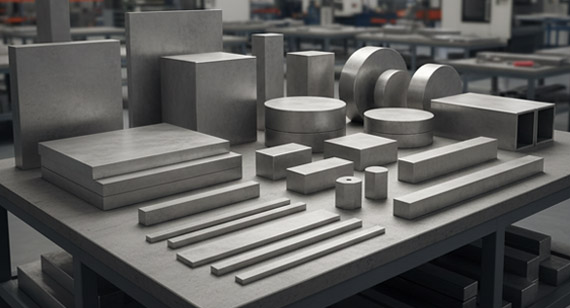
446 stainless steel is often compared to other ferritic stainless steels, such as 405 and 430 grades, due to its similar properties. However, it stands out for its superior resistance to oxidation at high temperatures. In some applications, 446 can also be considered equivalent to certain grades of Inconel for environments with extreme heat, though Inconel generally offers better overall high-temperature performance. Additionally, it is comparable to 304 stainless steel in terms of corrosion resistance, but the higher chromium content of 446 gives it an edge in high-temperature scenarios.
316 stainless steel is a highly corrosion-resistant austenitic alloy known for its ability to withstand harsh environments, including exposure to saltwater and acidic substances. It contains around 16% chromium, 10% nickel, and 2% molybdenum, which enhances its resistance to pitting and crevice corrosion. This alloy is commonly used in marine, chemical, and food processing industries, where resistance to both corrosion and high temperatures is crucial. Its durability and strength make it a go-to material for applications like pumps, valves, and marine equipment.
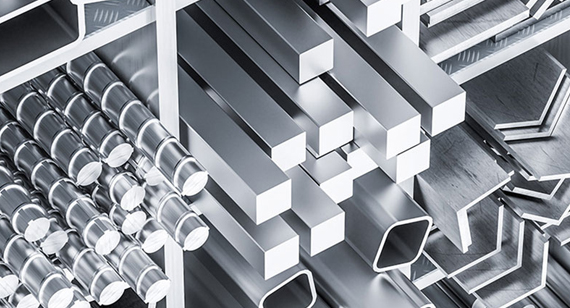
Both 446 and 316 stainless steels are recognized by international standards for their unique properties. For 446 stainless steel, the ASTM A240 standard applies, while 316 stainless steel is covered under ASTM A276 and A240. In terms of equivalent grades, 446 stainless steel has counterparts like UNS S44600 in the U.S. and 1.4762 in Europe. For 316 stainless steel, equivalent grades include UNS S31600 and 1.4401 in Europe. These grades ensure that both materials meet specific mechanical and chemical property requirements for various industrial applications.
National standards and equivalent grades for 446 and 316 stainless steel are shown:
| Stainless Steel Type |
National Standards |
Equivalent Grades |
| 446 Stainless Steel | ASTM A240 | UNS S44600, 1.4762 |
| 316 Stainless Steel | ASTM A276, ASTM A240 | UNS S31600, 1.4401 |
This table compares the standards and equivalent grades of the two stainless steels to help you better understand their application areas and different standards.
446 and 316 stainless steels are both popular choices for various industrial applications, but they differ significantly in their properties and performance. While 446 excels in high-temperature environments, 316 is more focused on corrosion resistance, especially in harsh, corrosive environments. Understanding their differences is key to selecting the right material for your specific project needs.
Composition
446 stainless steel is a ferritic alloy with around 23-27% chromium, providing it with excellent resistance to oxidation and scaling at high temperatures. 316 stainless steel, on the other hand, is an austenitic alloy containing 16% chromium, 10% nickel, and 2% molybdenum. The addition of molybdenum in 316 enhances its corrosion resistance, particularly against chlorides and other corrosive agents.
Hardness
446 stainless steel is known for its higher hardness compared to 316, making it more resistant to wear but also slightly more difficult to machine. 316 stainless steel, while still durable, is generally softer and easier to work with in machining processes.
Corrosion Resistance
316 stainless steel stands out for its superior resistance to corrosion, especially in marine and acidic environments, due to the presence of molybdenum. It offers excellent protection against pitting and crevice corrosion. While 446 stainless steel performs well in high temperatures, its corrosion resistance is not as robust in acidic or chloride-rich environments.
Wear Resistance
Due to its higher hardness, 446 stainless steel offers better wear resistance compared to 316, making it ideal for applications where abrasion and wear are concerns. However, 316’s resistance to corrosion typically outweighs its wear resistance in many industrial settings.
Oxidation Resistance
446 stainless steel performs excellently in environments exposed to high temperatures, offering exceptional resistance to oxidation. In contrast, 316 stainless steel’s oxidation resistance is more suited to moderate temperature environments but still performs well in less extreme conditions.
Welding
316 stainless steel is easier to weld compared to 446, which can be more challenging due to its higher chromium content. While both materials can be welded, special care must be taken when welding 446 stainless steel to avoid issues like brittleness or cracking.
Heat Resistance
446 stainless steel is designed for high-temperature applications and can withstand temperatures up to 2000°F (1093°C) without losing its structural integrity. 316 stainless steel has a lower heat resistance, withstanding temperatures up to around 1600°F (871°C), making it suitable for applications that involve moderate heat.
Machinability
316 stainless steel is generally easier to machine than 446 due to its lower hardness and toughness. While 446 provides excellent wear resistance, it may require more specialized machining techniques, which can increase costs and complexity during production.
Cost
The cost of 446 stainless steel is typically lower than 316 stainless steel, primarily due to the differences in composition. 316 stainless steel is more expensive because of its higher nickel and molybdenum content, which provides better corrosion resistance but comes at a higher price.
Applications
446 stainless steel is commonly used in high-temperature environments such as furnace parts, heat exchangers, and combustion chambers. 316 stainless steel, due to its superior corrosion resistance, is widely used in marine environments, chemical processing, food and pharmaceutical industries, and anywhere exposure to harsh chemicals or saltwater is a concern.
Table:Comparison of 446 and 316 Stainless Steel
| Property |
446 Stainless Steel |
316 Stainless Steel |
| Composition |
23-27% Chromium (Ferritic alloy) | 16% Chromium, 10% Nickel, 2% Molybdenum (Austenitic alloy) |
| Hardness |
Higher hardness, more resistant to wear but harder to machine | Softer, easier to machine but less wear-resistant |
| Corrosion Resistance |
Good resistance to high temperatures, but less corrosion-resistant in acidic or chloride-rich environments | Excellent resistance to corrosion, especially in marine and acidic environments |
| Wear Resistance |
Better wear resistance due to higher hardness | Lower wear resistance compared to 446 |
| Oxidation Resistance |
Excellent resistance to oxidation at high temperatures | Good oxidation resistance in moderate temperature environments |
| Welding |
More difficult to weld, special care needed | Easier to weld, commonly used in welding applications |
| Heat Resistance |
Withstands temperatures up to 2000°F (1093°C) | Withstands temperatures up to 1600°F (871°C) |
| Machinability |
More challenging to machine due to higher hardness | Easier to machine due to lower hardness and toughness |
| Cost |
Typically lower cost | More expensive due to higher nickel and molybdenum content |
| Applications |
High-temperature environments (furnace parts, heat exchangers) | Marine, chemical, food, and pharmaceutical industries |
This table should give a clear side-by-side comparison of the key differences between 446 and 316 stainless steels.
When choosing between 446 and 316 stainless steel, it's important to weigh the benefits and limitations of each. 446 stainless steel excels in high-temperature environments, offering superior oxidation resistance, while 316 stainless steel is unmatched in its corrosion resistance, especially in harsh, chloride-rich environments. However, each alloy comes with its own set of challenges in terms of machinability, cost, and performance in different conditions.
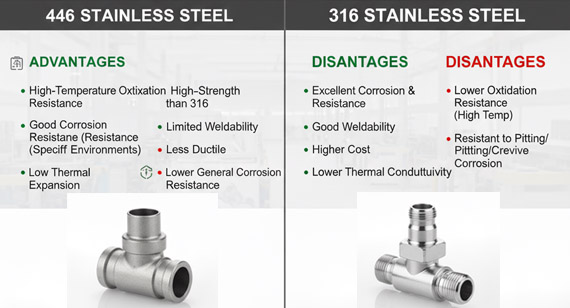
| Property |
446 Stainless Steel |
316 Stainless Steel |
| Advantages | - Excellent resistance to high-temperature oxidation | - Superior corrosion resistance, especially in marine and acidic environments |
| - Better wear resistance due to higher hardness | - Good weldability and machinability | |
| - Suitable for high-heat applications like furnace parts | - Ideal for food processing, pharmaceutical, and chemical industries | |
| Disadvantages | - More difficult to machine due to high hardness | - Less resistant to high temperatures than 446 |
| - Limited corrosion resistance in acidic or chloride-rich environments | - Higher cost due to added nickel and molybdenum content | |
| - More challenging to weld | - Not as wear-resistant as 446 |
This table helps you compare the main advantages and disadvantages of each material, assisting you in making an informed decision for your specific needs.
Understanding the key properties of 446 and 316 stainless steels can help determine which material is best suited for your specific project. The following comparison will highlight their differences in key mechanical and physical properties to guide your decision-making.
420 and 316 Stainless Steel: Chemical Composition
| Element |
420 Stainless Steel |
316 Stainless Steel |
| Carbon (C), % | 0.15-0.40% | 0.08% max |
| Chromium (Cr), % | 12-14% | 16-18% |
| Iron (Fe), % | Balance | Balance |
| Manganese (Mn), % | 0.50-1.00% | 2.00% max |
| Molybdenum (Mo), % | - | 2.00-3.00% |
| Nickel (Ni), % | - | 10-14% |
| Nitrogen (N), % | 0.10% max | 0.10% max |
| Phosphorus (P), % | 0.04% max | 0.045% max |
| Silicon (Si), % | 1.00% max | 0.75% max |
| Sulfur (S), % | 0.03% max | 0.030% max |
This table compares the chemical compositions of 420 and 316 stainless steels, highlighting the differences in key elements like chromium, nickel, and molybdenum. These variations directly influence the material’s performance in different applications.
446 and 316 Stainless Steel: Physical Properties
The physical properties of stainless steels play a critical role in their performance under various conditions. Here’s a comparison of key physical characteristics, including density, melting point, and thermal properties, to help you understand how 446 and 316 stainless steels behave in different environments.
| Property |
446 Stainless Steel |
316 Stainless Steel |
| Density | 7.8 g/cm³ | 8.0 g/cm³ |
| Melting Point (°C) | 1510-1530°C | 1375-1400°C |
| Thermal Conductivity (W/m·K) | 25-30 W/m·K | 16-20 W/m·K |
| Resistivity (Ω·m) | 0.0009-0.0011 Ω·m | 0.0007-0.0008 Ω·m |
| Thermal Expansion (10^-6/K) | 11.0-12.0 × 10^-6 K⁻¹ | 16.0-17.0 × 10^-6 K⁻¹ |
| Linear Thermal Expansion Coefficient (10^-6/K) | 11.5 × 10^-6 K⁻¹ | 16.0 × 10^-6 K⁻¹ |
| Corrosion Resistance | Good resistance at high temperatures but limited in acidic or chloride-rich environments | Excellent corrosion resistance, especially in marine and acidic environments |
| Magnetic Properties | Magnetic (ferritic) | Non-magnetic (austenitic) |
| Formability | Good for forming and bending at high temperatures | Excellent formability, especially at room temperature |
| Machinability (Annealing) | Moderate | Good |
| Environmental Adaptability | Excellent in high-temperature environments | Excellent in corrosive and moderate heat environments |
This table compares the physical properties of 446 and 316 stainless steels, showing how each material reacts to temperature changes, corrosion, and machinability in different environments.
446 Stainless Steel and 316 Stainless Steel: Mechanical Properties
The mechanical properties of stainless steels, such as hardness, tensile strength, and ductility, are crucial when selecting the right material for load-bearing or structural applications. Below is a comparison of the mechanical characteristics of 446 and 316 stainless steels.
| Property | 446 Stainless Steel | 316 Stainless Steel |
| Hardness (HRC) | 50-55 HRC | 45-50 HRC |
| Hardness (HV) | 450-500 HV | 200-250 HV |
| Tensile Strength (MPa) | 450-650 MPa | 520-700 MPa |
| Elongation (Rp0.2/MPa) | 15-25% | 40-50% |
| Ductility (%) | 15-20% | 40-50% |
| Ultimate Tensile Strength | 650 MPa | 700 MPa |
| Yield Tensile Strength | 350 MPa | 280-290 MPa |
| Reduction of Area (%) | 50-60% | 60-70% |
| Heating Temperature (°C) | Up to 2000°F (1093°C) | Up to 1600°F (871°C) |
| Elastic Modulus (GPa) | 200 GPa | 190 GPa |
| Fatigue Strength (MPa) | 170-250 MPa | 150-200 MPa |
| Shear Strength (MPa) | 300-450 MPa | 200-300 MPa |
| Shear Modulus (GPa) | 80 GPa | 75 GPa |
| Poisson's Ratio | 0.3 | 0.3 |
| Area Reduction (%) | 50-60% | 60-70% |
This table compares the mechanical properties of 446 and 316 stainless steels, giving you insight into their strength, ductility, and performance under stress.
Heat treatment processes are essential for enhancing the mechanical properties of stainless steel, such as hardness, tensile strength, and ductility. While both 446 and 316 stainless steels can undergo heat treatment, they each respond differently due to their composition and structural characteristics.
| Heat Treatment Process | 446 Stainless Steel | 316 Stainless Steel |
| Annealing Temperature | 1600-1650°F (870-900°C) | 1900-2050°F (1038-1121°C) |
| Hardening | Not typically hardened (Ferritic structure) | Can be hardened through cold working or solution annealing |
| Tempering | Not commonly tempered (Ferritic) | Can be tempered after hardening to adjust hardness |
| Quenching | Not generally required (Ferritic) | Water or air quenching after solution annealing |
| Solution Annealing | Not typically needed | Required for improved corrosion resistance and ductility |
| Stress Relieving | Useful for reducing internal stresses in welded or cast parts | Commonly performed to relieve stress in welds and formed parts |
The applications of 446 and 316 stainless steels vary significantly based on their unique properties. While 446 stainless steel is ideal for high-temperature applications, 316 stainless steel excels in environments where corrosion resistance is paramount. Here’s a breakdown of common uses for each material:
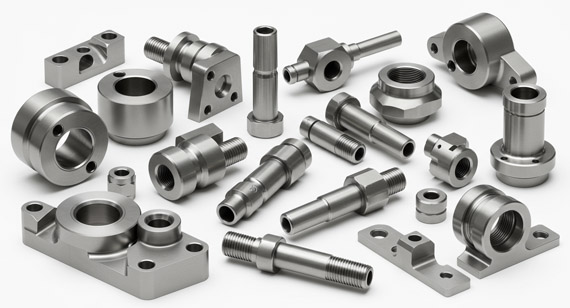
| Application |
446 Stainless Steel |
316 Stainless Steel |
| High-Temperature Applications | Furnace parts, heat exchangers, combustion chambers | Industrial ovens, heat exchangers (moderate temperatures) |
| Corrosive Environments | Limited use in chemical or marine environments | Marine, chemical processing, and pharmaceutical industries |
| Marine and Saltwater | Not ideal for saltwater exposure | Widely used in marine equipment, boat parts, and offshore structures |
| Food Processing | Rarely used due to potential corrosion concerns | Commonly used for food processing equipment and containers |
| Medical and Pharmaceutical | Not commonly used due to limited corrosion resistance | Used in surgical instruments, implants, and pharmaceutical manufacturing |
| Automotive and Aerospace | Exhaust systems, engine parts | Corrosion-resistant automotive components, aircraft parts |
| Industrial Equipment | Furnace components, boiler tubes | Chemical processing equipment, pumps, valves |
When comparing 446 stainless steel vs. 316 stainless steel, the overall costs are influenced by several factors, including material price, processing difficulty, and long-term benefits. Both alloys are high-quality stainless steels, but 446 offers better resistance to high temperatures, while 316 is renowned for superior corrosion resistance. Let’s break down the cost comparison.
Initial Cost Comparison
| Cost Factor |
446 Stainless Steel |
316 Stainless Steel |
| Material Price (per kg) | ~$3.0 – $4.5 | ~$5.0 – $7.5 |
| Initial Cost (per ton) | ~$3,000 – $4,500 | ~$5,000 – $7,500 |
| Corrosion Resistance | Lower than 316, but good for high temps | Higher due to added molybdenum |
Long-Term Cost Benefits
| Cost Factor |
446 Stainless Steel |
316 Stainless Steel |
| Durability | Excellent in high-temperature settings | Excellent for marine and chemical environments |
| Maintenance Costs | Lower, fewer corrosion-related repairs | Higher due to occasional corrosion in extreme conditions |
| Lifetime | Longer in high-temperature environments | Longer in marine or chemical exposure |
Processing Cost
| Processing Factor |
446 Stainless Steel |
316 Stainless Steel |
| Machining Difficulty | Moderate | High (due to alloying elements) |
| Tool Wear | Moderate | High (especially when machining thin sections) |
| Processing Cost per Hour | ~$30 – $45 | ~$45 – $65 |
Market Price
| Market Factor |
446 Stainless Steel |
316 Stainless Steel |
| Supply Availability | Less common, more niche | Widely available and in high demand |
| Global Price Variation | Price can vary by region |
Price tends to be more stable globally |
When choosing between 446 and 316 stainless steel, the decision depends on the specific environmental conditions, performance requirements, and cost considerations for your project. Both alloys offer excellent properties, but 446 stainless steel excels in high-temperature environments, while 316 stainless steel is better suited for corrosive and marine environments. Let’s break it down to help you make the right choice.
When Should You Use 446 Stainless Steel?
Tip: Choose 446 when your main challenge is heat resistance, and corrosion is less of a concern.
When Should You Use 316 Stainless Steel?
Tip: Choose 316 when your application demands the highest corrosion resistance in aggressive environments, especially those exposed to salt, acids, or chemicals.
Choosing between 446 stainless steel and 316 stainless steel depends on several critical factors, including the environment in which the material will be used, performance needs, and cost constraints. Both alloys have unique advantages, but understanding their strengths and limitations will ensure you choose the right material for your specific project.
When to Choose 446 Stainless Steel for Your Project
Tip: Use 446 for heat-intensive applications where corrosion isn’t a major issue, and budget considerations are key.
When to Choose 316 Stainless Steel for Your Project
Tip: Choose 316 when corrosion resistance and long-term performance in aggressive environments are top priorities for your project.
Final Decision: 446 vs. 316 Stainless Steel
At VMT, we specialize in producing high-quality stainless steel CNC machining parts, including both 446 stainless steel and 316 stainless steel components, tailored to meet the needs of industries such as automotive, aerospace, marine, and medical. Our expertise in stainless steel machining ensures precision, durability, and cost-effectiveness for every project.
Why Choose VMT for Stainless Steel CNC Machining?
Applications of Stainless Steel CNC Machining Parts
Tip: When ordering from VMT, provide clear specifications on the environmental conditions and performance requirements for your parts to ensure the right material is selected.
Why Trust VMT?
Key takeaway: Whether you need 446 stainless steel for high-temperature applications or 316 stainless steel for corrosion-resistant parts, VMT is your reliable partner for top-tier CNC machining services.
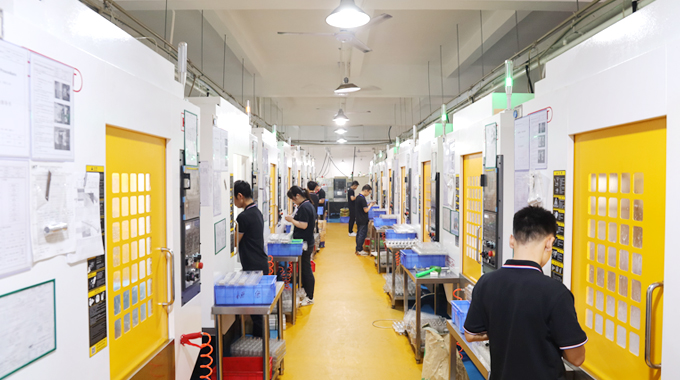
When comparing 446 stainless steel vs. 316 stainless steel, the best choice depends on your specific application needs. 446 stainless steel excels in high-temperature environments and offers cost-efficiency for projects where corrosion resistance is not a primary concern. On the other hand, 316 stainless steel provides unmatched corrosion resistance, making it ideal for marine, chemical, and medical applications, where durability and resistance to harsh environments are paramount.
In short, if your project demands heat resistance and budget considerations, 446 stainless steel may be the better option. However, if you need superior corrosion resistance for marine or chemical environments, 316 stainless steel is the ideal choice, even with the higher initial cost.
By carefully evaluating the operating conditions, performance requirements, and budget constraints, you can confidently choose the steel that best meets your project's needs.
1. Which is Better, 316 or 416 Stainless Steel?
316 stainless steel is superior in corrosion resistance, especially in chloride-rich environments like seawater, making it ideal for marine and chemical processing. 416 stainless steel is easier to machine but has lower corrosion resistance. If corrosion is a priority, 316 is the better choice, but for machining ease, 416 may be preferred.
2. What is the Difference Between 420 and 316 Stainless Steel?
420 stainless steel is a martensitic steel that can be hardened to higher levels, making it suitable for cutting tools and knives. 316 stainless steel is austenitic and known for its exceptional corrosion resistance, especially in marine and chemical environments. If corrosion resistance is the main concern, 316 is superior, but for hardening and strength, 420 may be better.
3. Which is Better, SS 304 or SS 316?
SS 316 is the better option for corrosion resistance, particularly in environments exposed to chlorides (e.g., seawater, chemicals). SS 304 is more affordable and still offers good corrosion resistance but doesn’t perform as well in aggressive environments. 316 is better for harsh conditions, while 304 is ideal for general-purpose use.
4. What are the Strength Grades of Stainless Steel?
Stainless steel is typically graded by its alloying elements, such as 304, 316, 410, and 430. Each grade has its own balance of strength, hardness, and corrosion resistance. The higher the carbon content, the stronger and harder the steel, but the lower the corrosion resistance (e.g., 440C is harder but more prone to rust than 316).
5. What is the Difference Between 4404 and 316 Stainless Steel?
4404 (a variant of 440 series stainless steel) is a martensitic steel, offering good hardness and wear resistance, typically used for cutlery and tools. 316 stainless steel, being austenitic, offers superior corrosion resistance, especially in marine and chemical environments. If corrosion resistance is essential, go for 316. If hardness is more critical, 4404 might be suitable.
6. Which Stainless Steel is Not Weldable?
Some high-carbon stainless steels, such as 440C or custom high-carbon alloys, can be more difficult to weld due to the risk of cracking. It's essential to preheat and post-heat treat these alloys to prevent issues. Most other stainless steels, such as 304 and 316, are weldable with appropriate procedures.
7. What Grade of Stainless Steel is Most Suitable for Machining?
Grades like 303, 416, and 17-4 PH are often considered the most machinable because of their sulfur and phosphorus content, which reduces friction and makes them easier to cut. 304 and 316 are more challenging to machine due to their high strength and galling potential.
8. What is the Machinability Level of 316 Stainless Steel?
316 stainless steel has moderate machinability compared to other grades. It can be challenging to machine due to its high strength and work-hardening properties. Using high-speed steel tools and coolants can help reduce tool wear and improve machining efficiency.
9. Can Magnets Hold 440 Stainless Steel?
Yes, 440 stainless steel is magnetic because it is a martensitic steel. Unlike austenitic steels (e.g., 304 and 316), which are non-magnetic, 440 stainless steel retains magnetic properties, making it suitable for magnetic applications.
10. Does Stainless Steel Rust?
While stainless steel is highly resistant to rust and corrosion, it is not entirely rust-proof. Exposure to harsh chemicals, high humidity, or saltwater can lead to corrosion over time. Grades like 316 offer superior corrosion resistance, but regular maintenance (cleaning and drying) is important to avoid rust formation.
11. What is the Best Grade of Stainless Steel for Welding?
316 stainless steel is generally considered the best grade for welding due to its excellent corrosion resistance and weldability. 304 stainless steel is also commonly used for welding, though it is more prone to corrosion in certain environments compared to 316. For welding in corrosive environments, 316 is usually preferred.
